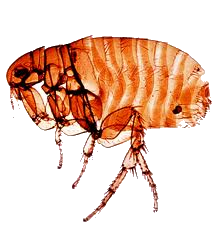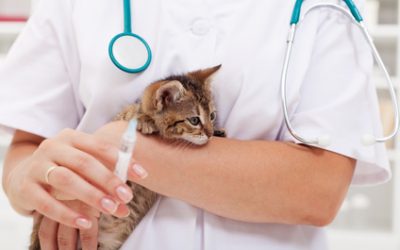It is not just owners that enjoy spending time with their pets, there are also many troublesome parasites that can live in or on our companions.
Ectoparasites live on the coat of pets, irritating and biting their skin. These include fleas, ticks, lice and mites. Many can transfer easily between animals directly or via bedding and the environment.
Endoparasites live within the internal organs of animals and can cause serious health problems. Pets are infected by eating things contaminated by parasite eggs or ingesting infected insects.
The most common endoparasites are roundworm and tapeworm but we can also see animals affected by hookworm, whipworm and lungworm.
Many of these parasites can also affect humans so for the health of our companions and ourselves it is important to prevent infestations. There are many methods of doing this and prevention programmes can be designed to suit the needs of each individual pet.
Our staff are always happy to give advice on parasite prevention and pets on our Pet Healthcare Scheme have year round treatment as part of their membership.
Ectoparasites
Fleas
Fleas are the most common external parasite affecting our pets. Their bites can cause irritation and trigger allergic skin reactions in both pets and people. In young animals a heavy flea burden can cause anaemia.
 They can also pass on tapeworm infection when animals groom themselves and ingest infected fleas. In rabbits they can transmit myxomatosis from infected wild rabbits to our pets.
They can also pass on tapeworm infection when animals groom themselves and ingest infected fleas. In rabbits they can transmit myxomatosis from infected wild rabbits to our pets. To control these troublesome guests on our companions we have to understand their life cycle.
Here are some key flea facts :-
-
The most common flea of cats and dogs is the cat flea Ctenocephalides felis
-
The rabbit flea Spilopsyllus cuniculi is larger than the cat flea. They can also be seen on cats and dogs, usually on the face and ears
-
Adult fleas on pets are only 5% of the flea population in the household, the rest of the life cycle involving eggs, larva and pupae continues in the carpets, floorboards and bedding.
-
Each adult female flea can lay up to 50 eggs per day. These eggs are very sticky and will be carried all around the house on socks and feet
-
Eggs hatch into larvae, which move away from light, deep into the carpets, floorboards and furniture
-
Larvae become pupae which can survive in the environment for up to a year. They hatch out into adult fleas in response to warmth and vibrations
-
This means that flea control needs to be a combination of treating pets and treating the house
Flea treatments can involve spot on preparations or tablets, with some lasting up to 12weeks. There are also collars giving protection for up to 8 months. Household treatment with sprays can keep environmental stages under control for up to a year
Our staff are happy to give advice and find a flea treatment which will best suit your pet. On our Pet Healthcare Scheme pets receive year round flea treatment and discounts off household sprays.
Ticks
Ticks are a blood sucking external parasite that climb onto passing animals and people from vegetation. Their bites can cause skin reactions and anaemia but can also transmit serious diseases such as Lyme disease and Babesiosis.
Here are some key tick facts :-
-
The most common tick in the UK is Ixodes ricinus
-
Other species of tick can be seen, particularly in pets travelling abroad. Tick prevention is an important part of preparation for taking pets on holiday especially as ticks in other countries can transmit other blood borne diseases
-
Ticks have 4 stages to their life cycle – eggs, larvae, nymphs and adults
-
The eggs are laid by adult females in the environment and hatch into larvae. The larvae will wait on vegetation and climb onto passing animals to feed
-
Once fed the larvae drop off the animal and develop into nymphs in the undergrowth.
-
Nymphs and adults follow a similar pattern, feeding on the animal and then dropping into the environment to continue to the next stage of the life cycle.
-
Ticks will not only use dogs and cats as hosts, they also feed from livestock, other wildlife and people
-
Tick saliva contains an anaesthetic so their bites are not initially noticed
-
They have barbed mouthparts for a strong attachment so cannot be simply pulled off. Pulling a tick from an animal can leave the mouth parts within the skin so it is important to get advice on how to remove them or we can do it for you
There are many treatments for tick prevention including tablets, spot on preparations and collars.
Please come and see our staff to discuss which is best for your pet. Read further here…
Mites
Mites are microscopic parasites that live on or within the skin. Different species of mite affect particular areas of the skin where they can cause severe irritation.
Their life cycle is spent entirely on the animal but most can be easily transferred by close contact with other pets. All treatments need to last for at least one mite life cycle, which is about 3 weeks for most species.
Types of mites seen in our pets include:-
Mange Mites
-
These burrow into the skin causing severe itching, self trauma and hair loss
-
Lesions may start on the face or legs but can progress across the whole body
-
Many species can affect humans too
-
Sarcoptes scabiei mostly affects dogs and can be acquired by to contact with infected foxes
-
Notoedres cati can be seen in cats
-
Trixicarus caviae infects guinea pigs sometimes causing such intense itching that the animal will appear to have seizures
-
Diagnosis can be made by skin scrapes and in the case of Sarcoptes an blood antibody test
Ear Mites
-
These mites live on the surface of the ear canal skin
-
Although they do not burrow they can still cause itching and inflammation of the ear and occasionally other areas of the skin.
-
Some animals, particularly cats, can carry the mites without clinical signs but pass them onto other pets
-
Otodectes cynotis is a common ear mite of cats, dogs and ferrets
-
Psoroptes cuniculi affects the ears of rabbits
-
Diagnosis can usually be made by looking in the ear with an otoscope but can also be confirmed by looking at wax samples under the microscope
-
Successful treatment requires cleaning of the ear as well as antiparasitic treatments
Demodex Mites
-
Demodex mites live within the hair follicles of cats and dogs and do not always cause disease
-
Clinical signs of infection can be seen in young animals or those with a reduced immune system
-
Although there can be hair loss caused by Demodex species it is usually not itchy
-
Diagnosis can be made by examining skin scrapings and hair pluckings under the microscope
Fur Mites
-
Cheyletiella species of mites live on the surface of the skin and hair
-
They can cause itching and excessive scale
-
Mites seen moving on the surface of the coat has been described as ‘walking dandruff ‘
-
Seen in dogs, cats and rabbits but can also bite humans
-
Diagnosis can be made by examining tape strippings from the coat under the microscope
Many of our regular flea treatments can also treat or prevent mite infections. If we feel that your pet may be at risk of mites then we can advise on the best treatment to use in your parasite prevention programme.
Harvest Mites
Trombicula autumnalis behaves differently than the other mites affecting pets
-
Most stages of the mite life-cycle live in undergrowth in the environment
-
The orange larval stages feed from animals for a few days causing severe itching and self trauma in some individuals
-
As larvae hatch out in late summer and autumn this is a seasonal problem
-
Usually affect areas of the animal in contact with grass, particularly feet, ears and lower abdomen
-
Diagnosis can be made by microscopy but often the season, site of lesions and visibility of orange mites is sufficient
-
Treatment usually requires local antiparasitic application along with oral steroids to reduce skin reaction to the larvae.
Lice
Lice are a less common external parasite, usually seen in young animals or those with a reduced immune system
-
Biting lice (Trichodectes canis in dogs, Felicola subrostratus in cats) cause itching and self trauma by irritation of the skin
-
Sucking lice (Linognathus setosus) are blood feeders and can cause anaemia in addition to itching
-
Lice can carry intermediate tapeworm stages which will infect pets when they ingest the lice in grooming
-
Can be seen without a microscope including the eggs cemented to hair shafts
-
Lice have a 4-6 week life cycle which takes place on the pet
-
They are very host specific so cat lice will not usually cause a problem for dogs and vice versa
-
Only certain parasite treatments will work against lice
Flystrike
In late Spring and Summer adult blowflies can lay their eggs on the skin of pets.
-
Eggs hatch into larvae which can invade deeper through the skin and body tissues.
-
In addition to irritation animals can rapidly develop severe illness from toxaemia.
-
Flies are attracted to blood or soiling with urine and faeces so pets with open wounds or diarrhoea are especially at risk.
-
Fly strike is a major problem in rabbits living outdoors in the summer
-
From May to September rabbits should be checked daily and have preventative treatments applied
Endoparasites
Roundworm
These are large white worms with cylinder shaped bodies. The most common types are Toxacara canis (dogs), Toxacara cati (cats) and Toxascaris leonina.
Adult worms live in the intestines causing weight loss or poor growth in young animals. Larvae cause damage by migrating through tissues, including the liver and lungs.
-

Infected animals pass out eggs in faeces (up to 87000 eggs per day per adult female worm) which contaminate soil
-
Larvae start to develop in these eggs and are well protected for months or years in the environment
-
Pets will ingest these eggs from the soil and larvae develop into adult worms in the intestine
-
Wildlife can also ingest the eggs so hunting pets can infected by this route too
-
Puppies become infected by worms from their mother as they are developing
-
Worm larvae can also be passed to puppies and kittens via their mother’s milk
-
Humans can also become infected with the main problems being caused by larva migrating through the tissues, including the eye, liver and lungs
Regular worming is important for the health of your pet and also preventing serious human infections.
Our worming programmes begin from the first arrival of your puppy and kitten and continue through their adult life.
Tapeworm
Tapeworm are long ribbon shaped worms divided into segments. Adult worms live in the intestine and release egg filled segments to pass out of the anus. The next stage of development of the tapeworm occurs in other animals or insects known as intermediate host. Cysts form in these hosts which will then be eaten by pets, causing tapeworm infection
-
Common tapeworms in dogs and cats include Dipylidium caninum and Taenia species
-
Each tapeworm species will have different intermediate hosts
-
Dipylidium is carried in fleas and lice so ectoparasite treatment is also important in control
-
Taenia cysts can develop in rabbits, small wildlife and farm animals. As a result hunting pets and those eating raw meat diets are most at risk
-
Infected pets may not show any signs of infection, although egg segments around the anus can be itchy.
-
Some species of tapeworm can develop cysts in humans if eggs are ingested
Not all worming treatments will cover roundworm and tapeworm so it is important to get advice on the best product for your pet.
Hookworm
These worms live in the small intestine attached by hook like mouthparts
-
Include Uncinaria and Ancylostoma species
-
Infection by larvae occurs via ingestion or migration through the skin of the feet
-
Severe infections can cause diarrhoea, blood loss from the intestine and anaemia
-
Can be carried by foxes and transmitted to pets
Whipworm
Trichuris vulpis has a thick head end and a thinner whip like tail
-
Live in the large intestine embedded into the wall
-
Heavy whipworm burdens can cause diarrhoea, low sodium levels and anaemia
-
Infection occurs by ingesting eggs from contaminated areas
-
Eggs are very resistant and can survive for months in the environment
Lungworm
There are several worms that affect the respiratory tract. They usually have slugs and snails as intermediate hosts which can infect pets if ingested.
-
Crenesoma vulpis lives in the airways and can be a problem in areas with infected fox populations
-
Oslerus osleri affects the trachea and is directly transmitted between dogs (without an intermediate host) including from mother to pups
-
Aelurostrongylus abstrusus infects the airways of cats after ingesting slugs, snails or small mammals
-
Angiostrongylus vasorum affects the deeper lung tissue, pulmonary arteries and right hand side of the heart. Can cause severe disease including coughing, anaemia, clotting problems and heart failure. Diagnosis can be made by faeces samples, lung washes and specific blood tests
If your pet is at risk of ingesting slugs or snails we can advise you on the best preventative treatments to include in your worming programme
Heartworm
The heart worm Dirofilaria immitus is transmitted to pets by certain species of mosquito
-
Larval stages called microfilaria pass into the blood stream from the biting mosquito
-
Adult worms develop in the heart and pulmonary arteries
-
Prevention is much better than treatment as death of large numbers of worms in a treated animal can also lead to severe illness
-
Currently not seen in pets living in the UK but prevention of infection is important in pets travelling abroad
Spring Greetings!
Spring greetings from us all at Prospect House Vets
Easter Opening Times at Prospect House
The Practice will be closed over the whole Easter Weekend
Vaccine shortages
We are unfortunately experiencing a supply shortage with some components of our Cat Vaccinations









